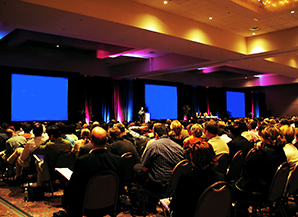


2018 Conferences: the Year of Robotic Process Automation (RPA)
No matter what industry you’re in, conferences are a reality of business life. The awesome speakers, the great connections, and live social media. Not only is it a way to network with new people, it is also a great way to learn from the best in your field.
In 2018, the theme of emerging technology and automation was Robotic Process Automation (RPA). Topics covered during presentations on RPA last year focused on defining the technology and the processes that are the best candidates for pilots. Fast forward a year later and things have started to progress.
This past year, we attended and presented at several conferences and learned that the conversation has moved from explaining the technology toward how to mature the offering of technology at an enterprise level.
It also became clear that companies, organizations, and agencies are at different stages and thought patterns when it comes to RPA. Below are four ideas we assessed.
- Security/Authority to Operate (ATO) — How to get through IT/Security approval continues to be a ‘mystery’ in government with no leading ‘best practice’. Agencies running RPA in a production environment are all taking different paths driven by the direction of their IT shops.
- Credentialing —Hand in hand with the ATO process is provisioning bots with credentials. Many agencies are running ‘attended’ bots using the developer’s credentials. But, for the government to get the full potential in savings from RPA, unattended bots should be used, requiring bots to have their own credentials. Although there are a handful of agencies running unattended bots, there isn’t a standard process for credentialing non-human entities (bots).
- There was also much conversation around the impact of OMB Memo M-19-17 which states that, “Agencies shall manage the digital identify lifecycle of devices, non-person entities (NPEs), and automated technologies such as RPA tools and Artificial Intelligence (AI), ensuring the digital identity is distinguishable, auditable, and consistently managed across the agency.”
- Setup of Center of Excellence (CoE) —Now that several agencies have bots running in production, the questions have moved away from technology and process selection toward administrative, by setting up an organization to manage this new wave of digital employees.
- To get started with RPA, most agencies focused on one or two areas to deploy bots so that managing the bots is much more controlled. Now that our understanding has matured, and the value of the technology is proved, other areas in agencies are taking notice and want to be next in line.
Many factors drive the setup of a CoE in an agency:- Relationship with IT
- The business areas in the agency
- CoE model —Centralized, decentralized or hybrid
- To get started with RPA, most agencies focused on one or two areas to deploy bots so that managing the bots is much more controlled. Now that our understanding has matured, and the value of the technology is proved, other areas in agencies are taking notice and want to be next in line.
- Path to production —Many agencies now in production with RPA started their journey with a pilot of a few processes to prove the value of the technology and ‘get their feet wet’ with learning how to use the software.
Now that lessons learned are shared and the return on investment is proved, many agencies are now questioning the worth of piloting. We think agencies should do the pilot. Although the technology is mature and its value proved, the IT and security work required for a pilot is needed to move to production.
The need for ‘best practices’ across government became evident and to address the issue, the Federal Robotic Process Automation Community of Practice was established. This group will provide an area for collaboration and information sharing and is responsible for producing a government-wide RPA Playbook. The technologies are maturing at a rapid rate and the federal government is also maturing in its use of the technology.
